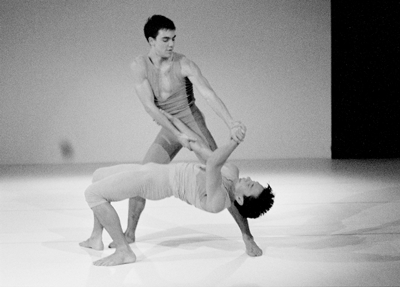The painter’s camera obscura is illuminated for Dusan Tynek’s groove
Learn to say Dusan Tynek. You may see this Czech born, young New York choreographer’s name in lights.
But in the intimate warm white box theater space of the Soho Joyce on December 5, T´ynek imagines the camera obscura, a tool for visualizing tableaux. He and Eden Mazer are costumed in the colors and style of the painter Egon Schiele and his Muse. They dance their passionate affair flying into the center stage floor from upstage corners.
Ted Reichman and Okkyung Lee play Reichman’s commissioned composition for accordian and cello. Its Elizabethan and Eastern European flavors sets the tone for T´ynek’s retro sensibility in “Camera Illuminata,” five dances inspired by paintings. T´ynek in “Death and the Maiden” looks like Schiele in a turpentine stained shirt. He is focused on Mazer who performs for him seductively wiggling her hips in bloomers. Finally they embrace, and she pushes him away. T´ynek falls backward with easy assurance, she with visible trepidation. Mazer is languid in lifts and a flip.
To Beethoven’s classic adagio from “Moonlight Sonata” Vincent McCloskey poses in a black brief like the figure in Hippolyte Flandrin’s “Young Male Nude Sitting by the Sea.” In “Genesis,” McCloskey sits embracing his knees, seemingly attached to the floor at point of contact. He creates himself in larger and larger movements. The supple dancer falls repeatedly on the sprung floor but then leaps into the air at blackout while we hold our breath.
The evening’s highlight is “Trinity,” inspired by a series of ten Carravagio’s depicting the life of Christ. Keith Sabado and Nicholas Duran are like two fauns coming out of a wood with light, flesh-colored unitards pulled down to their waist. They create a series of tableaux vivant based on poses of the figures in the paintings. In Roderick Murray’s nuanced lighting, the dancers are sometimes seen only in shadow. They pull up the leotards and dance in canonical or opposing movements to Heinrich von Biber’s “Sonata II.” They pose each other’s limbs like an artist would his figurine model’s bendable joints. Even with hands crossed at his groin, Sabado exudes a joi de vivre that heightens his performance to star quality.
“Pink Tree,” seen in the 2004 Dancenow/NYC, is in “Camera Illuminata” and is not as pristine as the new pieces. I have the same trouble with it that I do with John Currin’s paintings and Paul Taylor’s dancers’ feral expressions. The music is “Ecstasy” by Ali Jihad Racy. To this snake charmer style instrumental, Elise Osborne and Alexandra Berger perform a slow tango-tinged dance. The mix is heady and odd as Currin’s “The Pink Tree.” It’s performed in front of A. Christina Giannini’s painted pink “tree” prop. The costumes are like those worn in William Forsythe’s 1996 “Duo.” The translucent leotards don’t imagine the sweet and dour nudes with their medieval anatomy. Nevertheless the two move astutely; Osborne’s turns supported in a flying split.
Doors bang in the house and Tricia Brouk superbly staggers in. She sits at one of several tables for a dizzying performance of nods and swoons. The walls are absinthe green. In “Suicide by Drowning,” Devon Ludlow is the waiter who brings the chartreuse drink. Brouk loves the stuff. She stands and sways, stabilized by her incremental chicken walk. The emboldened absinthe drinker drops her skirt and dances more energetically on and around the tables. She lies back and lowers herself between them. The dulled pain, nausea and the wicked liquid all get the best of her and Ludlow drags her offstage. Degas’ “L’absinthe” inspired T´ynek and we are transported down to the last drop.
This young choreographer with a range of talents and choreographic tools began as a natural scientist. He retains that curiosity. Also a working painter, he is not afraid to dance with the masters. He is one of the few choreographers today working with plastique like Ashton did.



































